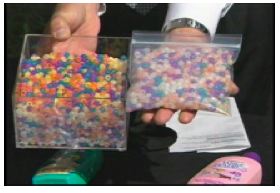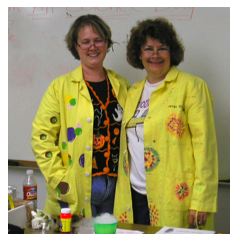UV Beads Help Students Understand the Importance of Sunscreen
 You might have seen t-shirts or special jewelry (beads) that changes color in sunlight. UV Beads look like ordinary white beads used to make a craft project, but embedded in the plastic is a special pigment that changes color when exposed to ultraviolet light. The color change takes place in just seconds – almost like magic. Mrs. Bratteli’s Third Grade Class from Aikin Elementary School in Paris, Texas, used the beads as a way to see if sunscreen lotion really blocks out harmful ultraviolet light from the sun.
You might have seen t-shirts or special jewelry (beads) that changes color in sunlight. UV Beads look like ordinary white beads used to make a craft project, but embedded in the plastic is a special pigment that changes color when exposed to ultraviolet light. The color change takes place in just seconds – almost like magic. Mrs. Bratteli’s Third Grade Class from Aikin Elementary School in Paris, Texas, used the beads as a way to see if sunscreen lotion really blocks out harmful ultraviolet light from the sun.
We did an experiment with your UV beads and sunscreen and the types were 10, 30, and 50 SPF. We put them each on a foam plate and had a nothing plate. [control—no sunscreen] They changed colors exactly how they were supposed to, but the 50 you couldn’t see. Read the full experiment write-up.
But, like all good experiments, these third graders discovered something else…

We left them all over the weekend and here are our results. The SPF 50 sunscreen also ate through the Styrofoam plate! The spf 10 did a little eating through the plate, but the 30 did not do a thing and neither did the nothing. Do you think using 50 and 10 SPF is dangerous or would effect us?
Here’s a great example of kids doing real science and making new observations and discoveries. As you might imagine, there’s nothing wrong with the kids’ sunscreen, but what they did discover is that something in the sunscreen reacted with the Styrofoam plate. It’s well known that fingernail polish remover (dilute acetone), spray glue, paints and other household chemicals react with Styrofoam, causing the polystyrene to quickly dissolve on contact. The students discovered something in their brand of sunscreen that caused a similar reaction.
 Hats off to Nancy Bratteli and Nicole Sumpter, third grade teachers at Aikin Elementary in Paris, Texas, who do a great job of getting their students excited about science throughout the year. Halloween is especially fun for these two when they host Aikin All-Day Science… and the kids go crazy. One of the prevailing themes in my training seminars is the need for turning ordinary activities into unforgettable learning experiences… and these teachers are doing it. Nice job.
Hats off to Nancy Bratteli and Nicole Sumpter, third grade teachers at Aikin Elementary in Paris, Texas, who do a great job of getting their students excited about science throughout the year. Halloween is especially fun for these two when they host Aikin All-Day Science… and the kids go crazy. One of the prevailing themes in my training seminars is the need for turning ordinary activities into unforgettable learning experiences… and these teachers are doing it. Nice job.
Want to try your own experiment using UV detecting beads? Take a look at these science project ideas and links…




Kids teach us so much about science. I am working with a middle school 21st Century class on a science elective they can choose to participate in over sports, art….
I have been using your demos for the past to years with great success with elementary students, but just after attending your summer session of Science in the Rockies felt like I could tackle middle school students.
I have started with semester with the GEMS dry ice unit, but found that at 5 in the afternoon with 6-8th graders this is a little lacking the “fun” factor to keep them engaged. After adding the crystal ball demo today, I has a child show me how I can keep costs down (I can’t get tons of the clear bowls for the cost factor.) but let them experience the fun. He used the Solo brand cup we were using. It worked great! I plan to get a class set of shoelaces and letting them make their own crystal ball next week!
Karen — You have to remember that 5 PM is a tough time for ANYONE to learn, let alone 6-8th graders (you have to love those sugar-hyped, Red Bull drinkin’, hormone raging middle schoolers). The Solo brand cup idea is great.
Thanks again for attending Science in the Rockies last summer. The potato gun fight was a blast!
Oh my gosh, I have perfected the crystal ball, and the kids love it, but I never thought about letting each kid have their own, with a solo cup and shoelace! Brilliant! 🙂
I can’t wait to see the excitement now! Thanks for this fabulous idea.
Where can I subscribe to your rss? You have good posts 🙂
Hi Kerry,
Thanks so much for your kind words about the blog! You can subscribe to the RSS by clicking the orange RSS button at the top of every page. Hope that helps and enjoy!
What an interesting topic. UV beads would be a great test subject for a number of different science fair projects. For example, they could be used to test your skin’s vulnerability in shade, partial sun and full sun. They can also be used to determine how much sun damage can be caused by indirect light and artificial light. Great blog post. Keep up the good work!
Students could also see if coating the beads with various types of sunblock impacts their reaction to UV rays.
Steve, Do you think that I should do the science fair? I mean I am only 11 years old.
Olivia – Absolutely! I think every student should participate in the science fair.
Hey. i love uv beads i am doing a science fair project on them WISH ME LUCK
Hi! Would like to use these uv beads for my science fair project but how would I measure degree of UV light based on the color change? Need to measure in metric. Want to compare different SPF levels. Thanks
sciencefan – there is no rubric for measuring the degree of color the beads produce, simply that there is the presence of UV light. You will see variations in color from pale to pastel to bright, though. Here is a link to the Steve Spangler Science website where you can view several experiments using the uv beads: https://www.stevespanglerscience.com/experiment/00000118